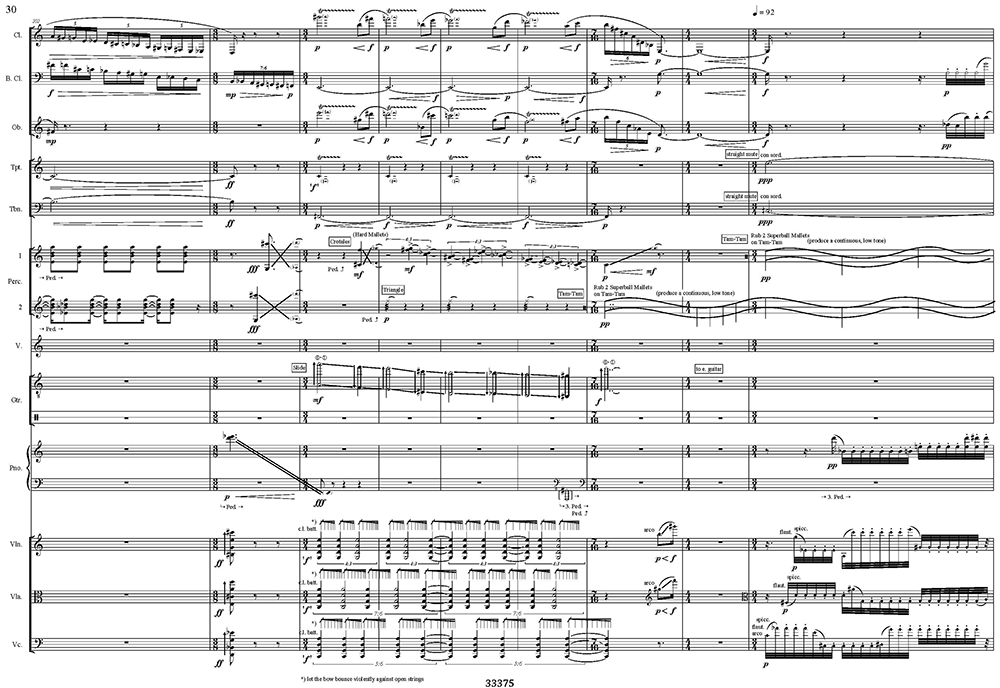Titel: Serenade
Instrumentation: Mezzo-Sopran und großes Ensemble
Jahr: 2012
Dauer: ca. 12.5′
Uraufführung: Levande Musik Festival 2012
Interpreten: Ensemble Gageego!
Hölderlin – Schönberg
Zitate erlauben es einer Komposition „ausgestoßenen“ Klängen Zuflucht zu gewähren. Es handelt sich um die Klänge, deren das ihnen angedichtete Gewicht abhanden kam als sich die Zeiten änderten und heute nur noch als erstarrte Klischees existieren. Ich „sättigte“ meine Komposition mit diesen Referenzen (Spätklänge, „die Asche ausgebrannter Bedeutungen“, in Anlehnung an Paul Celans Spätwort) um ihnen wieder die Möglichkeit zu bieten sich zu aktualisieren. Dazu verbinde ich dieses Material mit neuen Klängen zu einem gemeinsamen “Strukturklang“, mit dem ich wiederum neue Musik erschaffen kann – die Wirkung des ursprünglichen Materials bleibt dabei erhalten. Die Anspielungen auf tonales Material müssen in einer Komposition mehr bieten als eine simple alternative zu Geräuschhaftem, Seriellem, Stochastischem oder Computer-gesteuerten Klängen, wo Zitate meist nur als humanistisches Trostpflaster wirken. Das Material muss, anstelle „in Seitengassen oder Schutzhäuser geschoben zu werden“, sich mit dem anderen vermischen und die Haltung, dass „eines des anderen Abfall, Überschuss oder Müll ist“ herausfordern. So schreiben auch Reeve und Kerridge zur Gedichten Prynnes: „Müll ist was von den Zusammenstößen bleibt, wenn verschiedene Diskurse in fremde kulturelle Räume umgeleitet werden und kollidieren.“
Manchmal kann ein scheinbares Zitat einen schwerwiegenden Kontrast zu lyrischen Momenten bilden, so wie erregte Schreie im Spätwerk Beethovens nach außen dringen zu versuchen – „wie wenn der Komponist mit einer gewissen Gewalt einschreiten würde“. Diese „Schreie“ funktionieren weniger als zu verarbeitendes Material, sondern eher als Beschwörung, ähnlich wie Hölderlin historische Namen als Zeichen in seinen späten Gedichten anruft um so ein komplexes Bedeutungsuniversum zu generieren. Hölderlin erlaubte es der objektiven Qualität der Sprache zu sprechen, so wie auch der späte Beethoven alles überleitende Material wegschneidet und die Sprache pur für sich lässt. Er entwickelt eine intentionslose Sprache, „einen nackten Stein der überall bloßgestellt ist“, als ideale, offenbarte Sprache. Je mehr Hölderlin in seinen späten Gedichten der Welt näher kam (und seine Fähigkeit wuchs deren Essenz poetisch einzufangen), desto mehr erfuhr er deren Zerrissenheit und Ambivalenzen (und Unvereinbarkeit mit gewöhnlichen narrativen Strukturen) und geriet damit in Gefahr deren Bedeutungslosigkeit zu realisieren, da sie nur auf sich selbst verweisen – wie Wände oder Wetterhähne. Durch parataktische Konstruktionen fand er schlussendlich Zusammenhänge und Bedeutungen in der Geschichte und der Sprache selbst, wie im folgenden Gedicht zu sehen ist.
Mit gelben Birnen hänget
Und voll mit wilden Rosen
Das Land in den See,
Ihr holden Schwäne,
Und Trunken von Küssen
Tunkt ihr das Haupt
Ins heilignüchterne Wasser.
Weh mir, wo nehm’ ich, wenn
Es Winter ist, die Blumen, und wo
Den Sonnenschein,
Und Schatten der Erde?
Die Mauern stehn
Sprachlos und kalt, im Winde
Klirren die Fahnen.
Friedrich Hölderlin, Hälfte des Lebens (1804)
Meine Serenade, für Mezzosopran und großes Ensemble kombiniert dieses Spätwerk Hölderlins mit Elemente von Schönbergs Serenade, in der er selbst das Prinzip der Parataxe verwendet um einen leichten Serenaden-Stil (wie zu Beginn beim Marsch) neben das Petrarca-Sonett Seine Seele besucht sie im Schlaf im 4. Satz und das meditative Lied ohne Worte im 6. Satz zu stellen. Solche Nebeneinanderstellungen öffnen in Schönbergs Werk Räume, aufgeladen mit Zärtlichkeit aber auch Gewalt, und eröffnen den Blick auf unterdrückte und versteckte Verbindungen zwischen verschiedenen musikalischen Diskursen. Ich nehme den Schutt der sich einfach weigert zu verschwinden (versteinerte Klischees und tonale Muster sowie Geräusche) aus Schönbergs Stück, jene Momente die aus den oben genannten Räumen herausfallen, und rahme damit Hölderlins Text. Dieses Einrahmen betont die Materialität der Musik und kombiniert somit extreme, expressionistische Abstraktion mit geradezu „dokumentarischer“ Distanz, wie sie in den Geräuschen oder der Sprechstimme zu finden sind. Diese Stimme ist derart gestaltet, dass ihre Intonation und ihr Rhythmus Hölderlins Sprache nicht romantisiert oder grad psychologisiert, sondern den Worten erlaubt abseits vom Satzbau zu erklingen und sich mit der Musik an unerwarteten Stellen zu verbinden.
Link: www.wisemusicclassical.com/work/64675/Serenade–Ming-Tsao/


